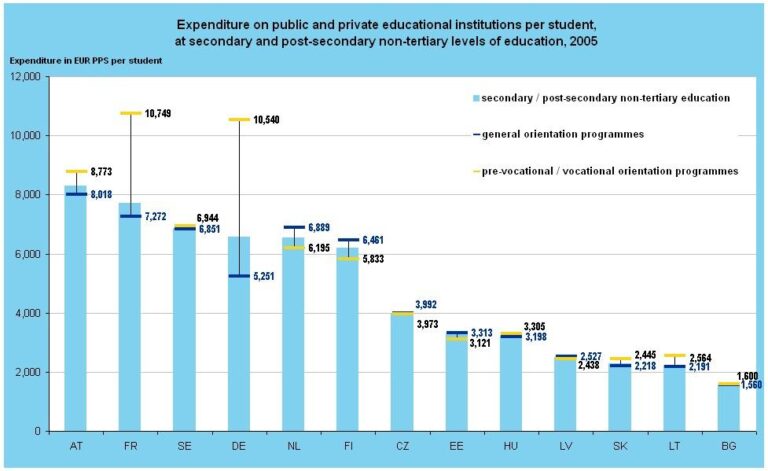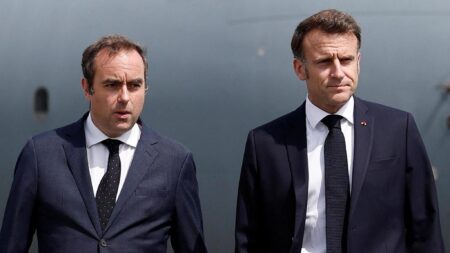Education expenditure as a percentage of FranceŌĆÖs GDP has been a key indicator of the nationŌĆÖs commitment to fostering learning and development over the past four decades. According to data compiled by Statista, tracking from 1980 through 2023 reveals distinct trends and shifts in government spending on education, reflecting broader economic, political, and social priorities. This article explores these patterns, providing insight into how France has allocated resources to education and what the implications may be for its future competitiveness and social outcomes.
Education Spending Trends in France Reveal Shifts Over Four Decades
Over the past 43 years, France has experienced notable fluctuations in its education spending relative to GDP, reflecting broader economic and policy shifts. From the early 1980s, when investment hovered around 5.5% of GDP, there was a gradual increase during the 1990s, coinciding with national initiatives aimed at improving educational infrastructure and accessibility. However, the early 2000s marked a period of stabilization, where expenditure plateaued near the 5% threshold, suggesting efforts to balance fiscal responsibility with educational commitments.
Recent years have brought renewed attention to education funding as the country addresses challenges from technological advancements and changing labor market demands. Key trends observed include:
- Increased emphasis on digital education tools, driving targeted budget allocations.
- Shifts in funding priorities toward vocational training and lifelong learning.
- Periodic boosts to primary and secondary education tied to demographic changes and policy reforms.
| Decade | Average % of GDP Spent | Notable Focus |
|---|---|---|
| 1980s | 5.3% | Expansion of public education |
| 1990s | 5.7% | Infrastructure modernization |
| 2000s | 5.0% | Cost containment and reform |
| 2010s | 5.2% | Digital learning integration |
| 2020-2023 | 5.4% | Focus on vocational and adult education |
Analyzing the Impact of Economic Policies on Education Budget Allocation
Economic policies have played a pivotal role in shaping the trajectory of France’s education budget over the past four decades. Shifts between austerity measures and stimulus packages are clearly mirrored in the fluctuating percentages of GDP designated for education expenditure. For instance, during periods of economic downturn, such as the early 1990s and late 2000s, there was a noticeable contraction in budget allocation, reflecting government priorities to stabilize the national economy. Conversely, phases marked by economic growth or reform initiatives often saw conspicuous increments in education spending, emphasizing the state’s commitment to fostering human capital development despite fiscal pressures.
Key influencing factors include:
- Changes in government leadership and their policy agendas
- Responses to unemployment rates and labor market demands
- European Union fiscal regulations and membership obligations
- Public demand for educational reform and innovation
| Time Period | Economic Policy | Education Spend (% GDP) |
|---|---|---|
| 1980-1990 | Expansionary | 5.2 |
| 1990-2000 | Austerity | 4.7 |
| 2000-2010 | Mixed | 5.0 |
| 2010-2023 | Investment Focus | 5.5 |
Challenges Faced by France in Maintaining Education Investment Levels
France has grappled with multiple economic and social constraints that significantly impact its capacity to consistently allocate sufficient funds for education. Economic downturns and fluctuating GDP growth rates often force policymakers to re-prioritize national spending, sidelining educational investments in favor of immediate fiscal stabilization measures. Additionally, demographic changes such as increasing student populations require higher operational costs, which stretch the existing budgets thin. These financial pressures manifest in challenges for schools to upgrade infrastructure and maintain favorable teacher-student ratios.
Beyond macroeconomic factors, political dynamics also play a key role in the inconsistencies of funding levels. Shifts in government priorities and competing interests from other public sectors can delay reforms and budget commitments crucial for education. Moreover, bureaucratic complexities and the intricate allocation system governing education funds often lead to inefficiencies and delayed disbursements. Key challenges include:
- Balancing centralized control with regional autonomy in fund distribution
- Addressing disparities between urban and rural educational infrastructure
- Managing rising costs associated with integrating digital learning tools
| Challenge | Impact on Education Investment |
|---|---|
| Economic Fluctuations | Reduced budget consistency |
| Demographic Pressure | Higher operational costs |
| Bureaucratic Delays | Slowed fund disbursement |
| Political Shifts | Unpredictable funding priorities |
Policy Recommendations to Enhance Education Funding Efficiency in France
To maximize the impact of education spending in France, policymakers should prioritize targeted resource allocation that aligns funding with demonstrable outcomes. Emphasizing investments in early childhood education and vocational training can bridge skill gaps while enhancing long-term economic prospects. Additionally, implementing stringent performance audits and fostering transparency can curb inefficiencies and redirect funds towards high-impact programs. Engaging stakeholders, including educators and local authorities, in budget planning will ensure that resources meet specific regional needs, optimizing expenditure effectiveness.
Innovative approaches to funding distribution should also be explored. For instance, performance-based incentives for schools can encourage improved student results without increasing overall expenditure. Integrating digital learning tools offers scalable cost savings and personalized education pathways, potentially reducing the per capita cost of instruction. The following table outlines key focus areas with suggested policy actions:
| Focus Area | Recommended Action | Expected Benefit |
|---|---|---|
| Early Childhood Education | Increase targeted subsidies | Improved literacy rates |
| Vocational Training | Expand apprenticeship programs | Higher employability |
| Performance Audits | Regular financial reviews | Reduced wasteful spending |
| Digital Integration | Investment in e-learning | Cost-effective personalized learning |
- Transparent budgeting: Public disclosure of fund allocation and outcomes
- Regional customization: Allocate resources based on local educational challenges
- Stakeholder collaboration: Include teachers and administrators in decision-making
Wrapping Up
In conclusion, the data on FranceŌĆÖs education expenditure as a percentage of GDP from 1980 to 2023 offers valuable insight into the countryŌĆÖs shifting priorities and economic commitments over more than four decades. While fluctuations reflect responses to broader economic conditions and policy reforms, sustained investment underscores FranceŌĆÖs ongoing dedication to education as a cornerstone of national development. As the landscape of education continues to evolve, monitoring these trends will remain essential for policymakers and stakeholders aiming to balance fiscal responsibility with the need to equip future generations.




